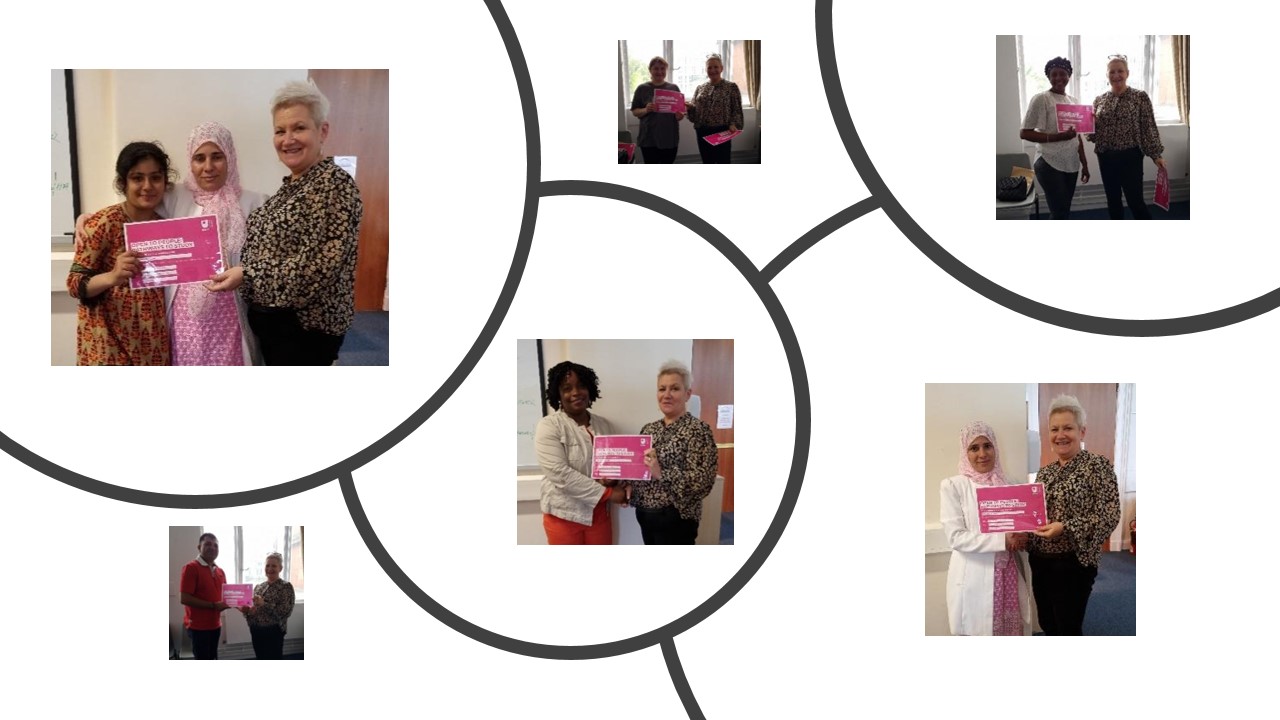As the pilot took place in the context of the continuing pandemic, there was an element of what Watters (2020) calls ‘disaster pedagogy’ which impacted the choices we made about the model of delivery. On reflection, we could have done more “careful thinking about teaching and learning” (Morris and Stommel, 2018) with forced migrants in a synchronous online context.
A pedagogy of care
We managed to include elements of a pedagogy of care (Bali, 2020) in the design of the pilot. Conscious of childcare, caring and work commitments, we offered a choice of morning or evening sessions when learners registered. We built in regular 1:1 sessions with tutors to provide opportunities for learners to identify and review their goals and the support they may need to achieve them. A ‘third space’ for learner support between tutor-led sessions was facilitated by the partner organisations, Bridges Programmes and the Scottish Refugee Council (SRC), for their participants.
Expanding on the pedagogy of care, we could have taken more time to develop a trauma-informed approach which acknowledged both the situations the learners have fled from and the continuing impact of the pandemic on both learners and teachers (Imad, 2020). The tutors felt they would have benefited from training in trauma-informed pedagogy to better understand and support their learners.
Synchronous online learning
The teaching took place in synchronous Zoom sessions, which reproduced a lecture-based classroom using slides. While the sessions also offered breakout rooms for learner interaction, Bali and Meier (2014) point out that synchronous dialogue “relies heavily on linguistic capital”. As our learners spoke English as a second/other language to varying levels of fluency this would likely have impacted their confidence to contribute to discussions.
Learners’ contributions may also have been impacted by cultural differences in learning and teaching, as some countries in the Global South retain colonial legacies of classroom styles that are now considered outdated in Europe (Sundaresan, 2020). This can make it difficult for the tutor to gauge understanding when learners are reluctant to question the person with authority.
‘One size fits few’
The pilot was delivered primarily through synchronous learning but we could have taken a Universal Design for Learning (UDL) approach at the outset and ensured learners had multiple means of engagement, representation and expression (CAST, 2018). For example, a web space for learners to access the course materials, slides and learning activities asynchronously as discussed in a previous post. We could also have provided online tools which would enable them to express their learning in different ways, such as audio or video recording tools.
One of the tools that learners reported benefiting from was a learning journal. This was introduced in Week 4 to develop reflection skills but it also enabled them to engage with their learning and express themselves asynchronously. “Learning journal helps me reflect on what I been taught in class, record my thoughts on any difficulties or challenges am facing.“
‘Screen exhaustion‘
Because of the ongoing pandemic, the face-to-face support that Bridges Programmes and the Scottish Refugee Council (SRC) would usually offer wasn’t back in place. They reported that it was a challenge to support learners who were struggling with technology. As support sessions were also online, one partner felt “screen exhaustion” was a factor for learners in accessing this.
As discussed in a previous post, any future delivery would incorporate a face-to-face induction prior to the online taught programme to develop learners’ digital literacies and confidence.
A blended model
In the evaluation, some learners expressed a preference for face-to-face interaction, but others said online learning suited them due to childcare, work or caring commitments. When asked about the model of delivery only two would like the course to be wholly online in the future, three would prefer face-to-face, while four would prefer a blended approach.
“I could do classes in my pyjamas and still have time at home with the baby.”
“For me it was very good but doing it face to face will be good as you can interact with the people you are doing the course with.”
A blended approach would give learners the option of learning online, accessing face-to-face support, using digital devices and wifi in Bridges Programmes or the Scottish Refugee Council, or learning as a group. This would be a similar model to the project Bridges Programmes and the OU in Scotland partnered on in 2014/15.
Learning from this pilot, incorporating UDL principles at the outset and providing a web space for learners to access the course materials, slides and learning activities asynchronously could better support learner agency and autonomy.
Bali, M. (2020). ‘Pedagogy of care: Covid-19 edition’, Reflecting Allowed, 28 May. Available at: https://blog.mahabali.me/educational-technology-2/pedagogy-of-care-covid-19-edition/ (accessed 23 April 2023).
Bali, M. and Meier, B. (2014). ‘An Affinity for Asynchronous Learning’, Hybrid Pedagogy, 4 March. Available at: https://hybridpedagogy.org/affinity-asynchronous-learning (Accessed: 10 May 2023).
CAST (2018). UDL Guidelines: Optimize individual choice for autonomy. Available at: https://udlguidelines.cast.org/engagement/recruiting-interest/choice-autonomy (Accessed: 6 June 2023).
Imad, M. (2020). ‘Leveraging the Neuroscience of Now’, Inside Higher Ed. Available at: https://www.insidehighered.com/advice/2020/06/03/seven-recommendations-helping-students-thrive-times-trauma (Accessed: 24 April 2022).
Morris, S. M. and Stommel, J. (2018) ‘Why Online Programs Fail, and 5 Things We Can Do About it’, in Morris, S. M. and Stommel, J. (eds.) An Urgency of Teachers: the Work of Critical Digital Pedagogy. Available at: https://criticaldigitalpedagogy.pressbooks.com (Accessed: 10 May 2023).
Sundaresan, J. (2020) ‘Decolonial reflections on urban pedagogy in India’, Area, 52(4), pp. 722–730.
Watters, A. (2020) ‘Robot teachers, racist algorithms, and disaster pedagogy’, Hack Education, 3 September. Available at: http://hackeducation.com/2020/09/03/racist-robots (Accessed: 1 May 2023).

